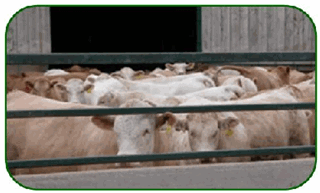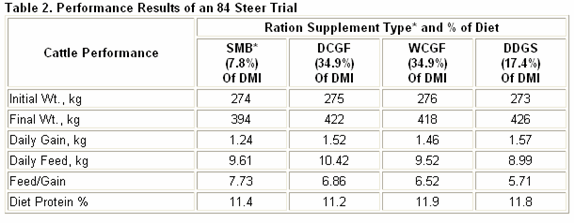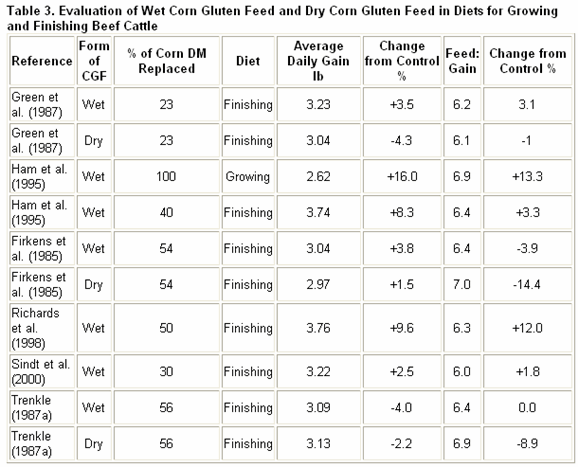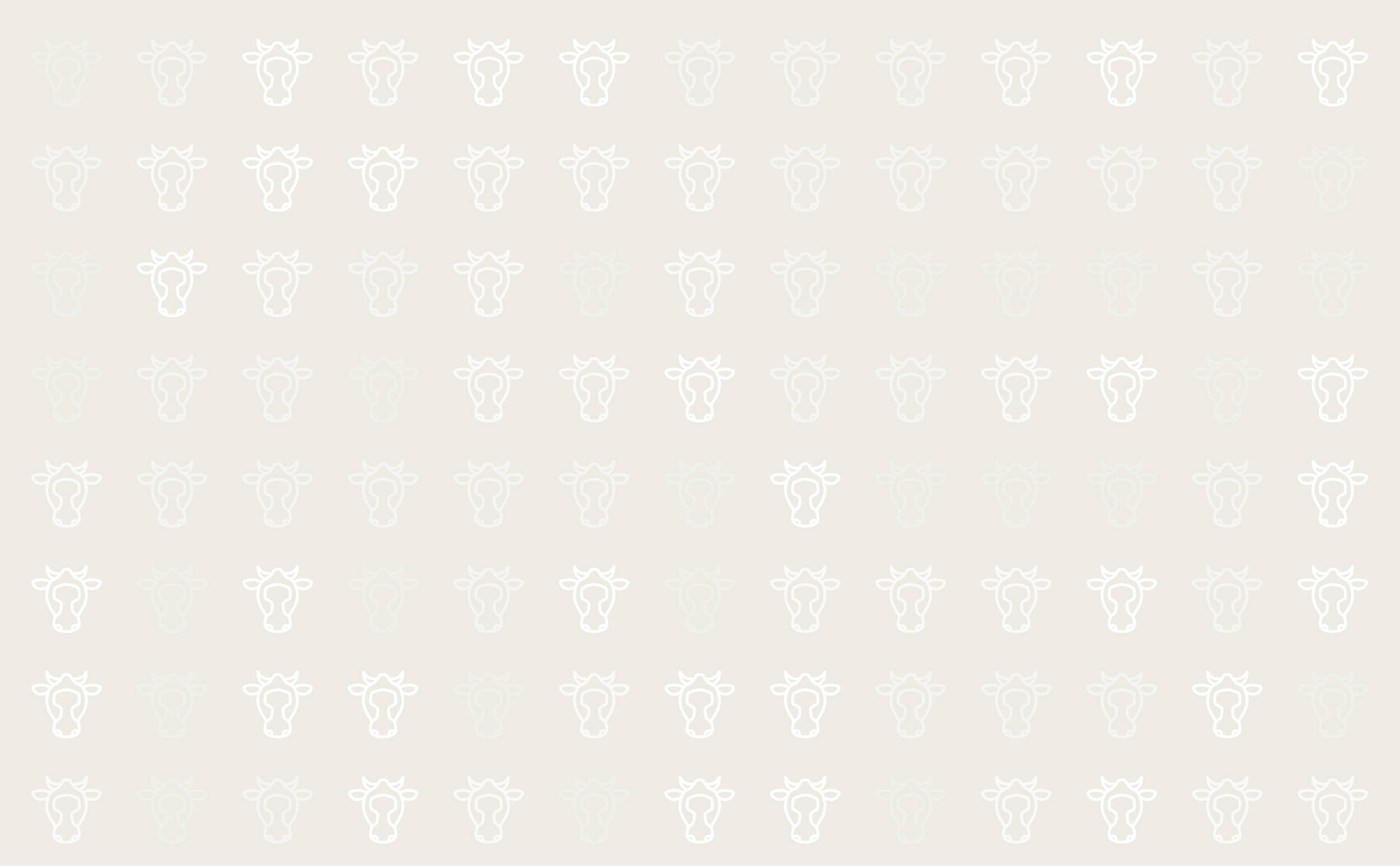



Corn Gluten Feed or Corn Distillers, Which Should I Feed?
By Ron Lackey - Feed Ingredients and By-products Feeding Specialist/OMAFRA.Corn co-products such as corn distillers with solubles (DGS) from ethanol production, or corn gluten feed (GCF), have both been shown through extensive research to be highly digestible alternative sources of protein, energy and phosphorus (see Table 1). They can optimize performance and reduce feed costs when incorporated into beef growing and finishing rations.
The most common question asked is: "One person is saying that I should be feeding corn distillers while another is saying I should use corn gluten feed. When I compare the two products for relative value, on an energy and protein basis, they seem similar - which one is best for growing (backgrounding) and which is best for finishing - or are they the same?"
 |
|
Figure 1: Feedlot cattle can utilize corn processing co-products effectively
|
Both are co-products of corn processing, so there are a number of similarities. However, because they are from two different systems there are some nutrient differences which are important considerations in their evaluation.
Corn gluten feed is a co-product of the wet corn milling industry that extracts the starch from corn, which is then further processed to make fructose, or fermented to produce ethanol. Corn distillers (ethanol) on the other hand is a co-product of the dry milling industry that focuses on converting the starch from the corn to sugar which is then fermented to produce ethanol.
Both are good sources of protein, energy and phosphorus for beef cattle. Both contain low levels of starch. Much of the benefit of these co-products is the fact that their energy content comes from the highly digestible residual fibre content. This fibre component is beneficial in reducing acidosis in high grain rations and also aids in fibre digestion when fed in high forage rations. Both are available in dried (DDGS and DCGF) or wet form (WDGS andWCGF). The wet products offer some performance advantages but with potential transportation and storage challenges that can limit their use.

However, the distillers co-products have higher energy levels (largely from higher oil or fat content) and higher protein levels, making them more nutrient dense than gluten feed (CGF). As well, the protein in the distillers has a higher percentage (55-60%) of escape or bypass protein (UIP, undegradable intake protein) than the corn gluten feed, which has only 20-22% UIP, and correspondingly higher levels (78-80%) of soluble protein (DIP, degradable intake protein).
So, which is best for growing cattle and which is best for finishing? Or are they the same? Unfortunately, based on information from many research trials there is not be a straight forward easy answer. Beef producers who have fed these co-products for a number of years probably have a personal favourite. However, based on research and scientific theory I have some recommendations.Growing /Backgrounding
For growing or backgrounding rations my preference would be the corn gluten feed. Much of the research indicates better animal performance using CGF in higher roughage feeding programs than in high grain or concentrate diets. According to researchers at Kansas State University, "The energy value of corn gluten feed relative to corn increases in high roughage diets. It supplies additional energy without the negative associative effects on fibre that can occur when high levels of grain are fed. By not retarding fibre digestion, CGF increases total digestibility of these high roughage diets, thereby increasing cattle performance."
CGF's lower protein levels , low fat and low starch content make it a compatible alternative that can be fed at relatively high inclusion rates, effectively providing the required protein as well as replacing a large portion of the grain in growing diets. However, to optimize animal performance by balancing the UIP/DIP protein fractions, another source of UIP may need to be supplemented due to the lower levels in the protein fraction of GCF.On the other hand, it could be said that distillers grains, with the higher levels of UIP would do a better job in providing the type of protein necessary for growing /backgrounding cattle. Also, because DGS are more nutrient dense, lower inclusion rates may be an advantage depending on the supply of other, possibly home grown ingredients.

Firkins et al
*SBM = soybean meal, DCGF = dried corn gluten feed, WCGF = wet corn gluten feed, DDGS = dried distillers grains with solubles
Although there has been extensive corn co-product feeding research conducted, very few trials actually compared corn distillers directly with corn gluten feed. The results shown in Table 2 are an exception, and demonstrate superior performance for both distillers and corn gluten feed.
Finishing
In the finishing stage, we are usually trying to maximize energy intake, so my preference would be to use the distillers. By using the corn distillers to provide the necessary protein requirements we can also give the ration a bit of energy boost (higher oil content in the distillers). But, as pointed out, the DGS have 55-60% UIP. Finishing cattle need a greater amount of DIP than UIP. In finishing rations where DIP levels are not being met when including distillers, some urea may need to be included.
On the other hand, field trials at the University of Nebraska with Scott and others demonstrated that when WCGF was included in finishing rations (regardless of the type of grain processing) cattle gained 6% faster than steers fed diets that did not include WCGF. Steers fed SFC (steam flaked corn) plus WCGF gained 8% faster and steers fed SFC or SFC + WCGF gained 10% more efficiently than all other treatment groups.Table 3 is a summary of the results from 10 different feeding trials in which corn gluten feed was included as part of the ration.

Processing Considerations
Researchers have looked at cattle performance when the dietary corn was processed with different methods and then fed in combination with corn distillers grains or with corn gluten feed. Results are shown in Tables 4, 5 and 6.

(Macken et al., 2006).
*DRC = dry rolled corn, FGC = fine ground corn, FRC = fine rolled corn, RHMC = rolled high moisture corn, GHMC = ground high moisture corn, SFC = steam flaked corn, whole = whole corn

(Scott et al., 2003)
*DRC = dry rolled corn, FGC = fine ground corn, FRC = fine rolled corn, RHMC = rolled high moisture corn, GHMC = ground high moisture corn, SFC = steam flaked corn, whole = whole corn
Vander Pol et al., 2006
DRC = dry rolled corn, FGC = fine ground corn, HMC = high moisture corn, SFC = steam flaked corn, whole = whole corn
While it is important to point out that these trials incorporated the wet co-products, the results do illustrate that there can be performance differences dependant on the type of processing used with the corn portion of the ration. One could conclude that WCGF works best in combination with steam flaked corn, while the WDGS may work best with dry rolled or high moisture corn.
Inclusion Rates
Considerable attention has been directed toward maximum and optimal inclusion rates of these co-products. The low starch and high fibre levels of these co-products lend themselves to potentially high inclusion rates, but their medium protein levels, relatively high phosphorus and sulphur content do set some limits from an environmental and animal health perspective.
Recent work out of Nebraska is now suggesting optimum inclusion rates of 20% of the ration for dried distillers with solubles, summarized in Table 7.Other conclusions from researchers suggest wet corn gluten feed is more digestible than dry corn gluten feed and can replace up to 50% of the dry rolled corn, or 30% of the steam flaked corn in finishing rations without negatively affecting performance. Dry CGF can replace up to 25% of dry rolled corn in beef finishing rations before reductions in cattle performance begin to occur.
If you are still unsure as to which to use there is research that demonstrates benefits to feeding a combination of both corn distillers and corn gluten feed.
Combinations
If you are still unsure as to which to use there is research that demonstrates benefits to feeding a combination of both corn distillers and corn gluten feed. Researchers at the University of Nebraska conclude that diets containing 30% of both WCGF and WDGS improved performance compared to cattle fed no co-products. Optimum ADG and F:G were achieved with inclusion levels of WDGS ranging from 15 to 20% in diets that also contain 30% WCGF.
The bottom line seems to be that both of these corn co-products are good alternative feed ingredients that can improve performance and potentially save money on feed costs. In the process of evaluating these co-products it is important to recognize, understand and account for the nutrient differences between corn distillers and corn gluten feed, both from the standpoint of balancing a ration and making purchasing decisions. If you use a balanced approach to decision making you will probably be satisfied with the performance of the combination of these co-product feeds that you choose.
References
J.L. Firkins, L.L. Berger, G.C. Fahey,Jr - Evaluation of Wet and Dry Distillers Grains and Wet and Dry Corn Gluten Feeds For Ruminants. J.Anim.Sci. 1985. 60 847-860
G.E. Erickson, T.J.Klopfenstein, K.Vander Pol, V.Bremer & P.Loza-Feeding of Wet Corn Milling Byproducts To Beef Cattle-66th Minnesota Nutrition Conference Proceedings 2005
2007 Nebraska Beef Cattle Report Summaries-University of Nebraska
"Corn Gluten Feed-Composition and Feeding Value for Beef and Dairy Cattle"-Kansas State University
February 2008


